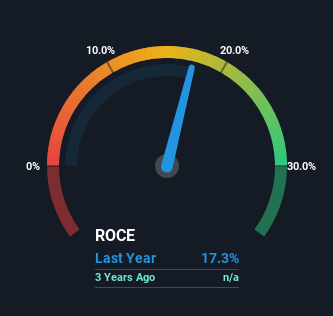- United States
- /
- Semiconductors
- /
- NasdaqCM:TOYO
TOYO (NASDAQ:TOYO) Shareholders Will Want The ROCE Trajectory To Continue
Finding a business that has the potential to grow substantially is not easy, but it is possible if we look at a few key financial metrics. Amongst other things, we'll want to see two things; firstly, a growing return on capital employed (ROCE) and secondly, an expansion in the company's amount of capital employed. Basically this means that a company has profitable initiatives that it can continue to reinvest in, which is a trait of a compounding machine. Speaking of which, we noticed some great changes in TOYO's (NASDAQ:TOYO) returns on capital, so let's have a look.
Return On Capital Employed (ROCE): What Is It?
For those who don't know, ROCE is a measure of a company's yearly pre-tax profit (its return), relative to the capital employed in the business. The formula for this calculation on TOYO is:
Return on Capital Employed = Earnings Before Interest and Tax (EBIT) ÷ (Total Assets - Current Liabilities)
0.17 = US$12m ÷ (US$238m - US$169m) (Based on the trailing twelve months to December 2023).
Therefore, TOYO has an ROCE of 17%. On its own, that's a standard return, however it's much better than the 9.0% generated by the Semiconductor industry.
Check out our latest analysis for TOYO

Historical performance is a great place to start when researching a stock so above you can see the gauge for TOYO's ROCE against it's prior returns. If you're interested in investigating TOYO's past further, check out this free graph covering TOYO's past earnings, revenue and cash flow.
What Can We Tell From TOYO's ROCE Trend?
TOYO has recently broken into profitability so their prior investments seem to be paying off. About one year ago the company was generating losses but things have turned around because it's now earning 17% on its capital. In addition to that, TOYO is employing 759% more capital than previously which is expected of a company that's trying to break into profitability. This can tell us that the company has plenty of reinvestment opportunities that are able to generate higher returns.
On a side note, we noticed that the improvement in ROCE appears to be partly fueled by an increase in current liabilities. Effectively this means that suppliers or short-term creditors are now funding 71% of the business, which is more than it was one year ago. And with current liabilities at those levels, that's pretty high.
The Key Takeaway
Long story short, we're delighted to see that TOYO's reinvestment activities have paid off and the company is now profitable. Astute investors may have an opportunity here because the stock has declined 61% in the last year. So researching this company further and determining whether or not these trends will continue seems justified.
TOYO does have some risks, we noticed 5 warning signs (and 4 which don't sit too well with us) we think you should know about.
While TOYO isn't earning the highest return, check out this free list of companies that are earning high returns on equity with solid balance sheets.
Valuation is complex, but we're here to simplify it.
Discover if TOYO might be undervalued or overvalued with our detailed analysis, featuring fair value estimates, potential risks, dividends, insider trades, and its financial condition.
Access Free AnalysisHave feedback on this article? Concerned about the content? Get in touch with us directly. Alternatively, email editorial-team (at) simplywallst.com.
This article by Simply Wall St is general in nature. We provide commentary based on historical data and analyst forecasts only using an unbiased methodology and our articles are not intended to be financial advice. It does not constitute a recommendation to buy or sell any stock, and does not take account of your objectives, or your financial situation. We aim to bring you long-term focused analysis driven by fundamental data. Note that our analysis may not factor in the latest price-sensitive company announcements or qualitative material. Simply Wall St has no position in any stocks mentioned.
About NasdaqCM:TOYO
TOYO
Engages in the upstream production of wafer and silicon, midstream production of solar cell, downstream production of photovoltaic (PV) modules, and other stages of the solar power supply chain in Asia and the United States.
Slight risk and slightly overvalued.
Similar Companies
Market Insights
Weekly Picks


Crazy Undervalued 42 Baggers Silver Play (Active & Running Mine)


Fiducian: Compliance Clouds or Value Opportunity?

Willamette Valley Vineyards (WVVI): Not-So-Great Value
Recently Updated Narratives

SLI is share to watch next 5 years


The "Molecular Pencil": Why Beam's Technology is Built to Win

PRME remains a long shot but publication in the New England Journal of Medicine helps.
Popular Narratives


MicroVision will explode future revenue by 380.37% with a vision towards success


NVDA: Expanding AI Demand Will Drive Major Data Center Investments Through 2026




